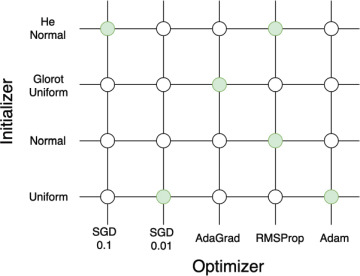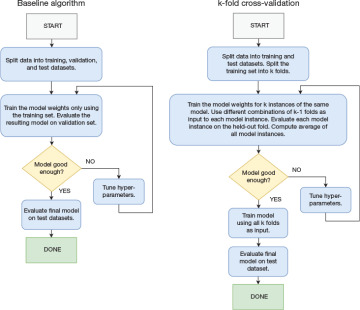- Programming Example: Moving to a DL Framework
- The Problem of Saturated Neurons and Vanishing Gradients
- Initialization and Normalization Techniques to Avoid Saturated Neurons
- Cross-Entropy Loss Function to Mitigate Effect of Saturated Output Neurons
- Different Activation Functions to Avoid Vanishing Gradient in Hidden Layers
- Variations on Gradient Descent to Improve Learning
- Experiment: Tweaking Network and Learning Parameters
- Hyperparameter Tuning and Cross-Validation
- Concluding Remarks on the Path Toward Deep Learning
Hyperparameter Tuning and Cross-Validation
The programming example showed the need to tune different hyperparameters, such as the activation function, weight initializer, optimizer, mini-batch size, and loss function. In the experiment, we presented five configurations with some different combinations, but clearly there are many more combinations that we could have evaluated. An obvious question is how to approach this hyperparameter tuning process in a more systematic manner. One popular approach is known as grid search and is illustrated in Figure 5-13 for the case of two hyperparameters (optimizer and initializer). We simply create a grid with each axis representing a single hyperparameter. In the case of two hyperparameters, it becomes a 2D grid, as shown in the figure, but we can extend it to more dimensions, although we can only visualize, at most, three dimensions. Each intersection in the grid (represented by a circle) represents a combination of different hyperparameter values, and together, all the circles represent all possible combinations. We then simply run an experiment for each data point in the grid to determine what is the best combination.

FIGURE 5-13 Grid search for two hyperparameters. An exhaustive grid search would simulate all combinations, whereas a random grid search might simulate only the combinations highlighted in green.
What we just described is known as exhaustive grid search, but needless to say, it can be computationally expensive as the number of combinations quickly grows with the number of hyperparameters that we want to evaluate. An alternative is to do a random grid search on a randomly selected a subset of all combinations. This alternative is illustrated in the figure by the green dots that represent randomly chosen combinations. We can also do a hybrid approach in which we start with a random grid search to identify one or a couple of promising combinations, and then we can create a finer-grained grid around those combinations and do an exhaustive grid search in this zoomed-in part of the search space. Grid search is not the only method available for hyperparameter tuning. For hyperparameters that are differentiable, it is possible to do a gradient-based search, similar to the learning algorithm used to tune the normal parameters of the model.
Implementing grid search is straightforward, but a common alternative is to use a framework known as sci-kit learn.3 This framework plays well with Keras. At a high level, we wrap our call to model.fit() into a function that takes hyperparameters as input values. We then provide this wrapper function to sci-kit learn, which will call it in a systematic manner and monitor the training process. The sci-kit learn framework is a general ML framework and can be used with both traditional ML algorithms as well as DL.
Using a Validation Set to Avoid Overfitting
The process of hyperparameter tuning introduces a new risk of overfitting. Consider the example earlier in the chapter where we evaluated five configurations on our test set. It is tempting to believe that the measured error on our test dataset is a good estimate of what we will see on not-yet-seen data. After all, we did not use the test dataset during the training process, but there is a subtle issue with this reasoning. Even though we did not use the test set to train the weights of the model, we did use the test set when deciding which set of hyperparameters performed best. Therefore, we run the risk of having picked a set of hyperparameters that are particularly good for the test dataset but not as good for the general case. This is somewhat subtle in that the risk of overfitting exists even if we do not have a feedback loop in which results from one set of hyperparameters guide the experiment of a next set of hyperparameters. This risk exists even if we decide on all combinations up front and only use the test dataset to select the best performing model.
We can solve this problem by splitting up our dataset into a training dataset, a validation dataset, and a test dataset. We train the weights of our model using the training dataset, and we tune the hyperparameters using our validation dataset. Once we have arrived at our final model, we use our test dataset to determine how well the model works on not-yet-seen data. This process is illustrated in the left part of Figure 5-14. One challenge is to decide how much of the original dataset to use as training, validation, and test set. Ideally, this is determined on a case-by-case basis and depends on the variance in the data distribution. In absence of any such information, a common split between training set and test set when there is no need for a validation set is 70/30 (70% of original data used for training and 30% used for test) or 80/20. In cases where we need a validation set for hyperparameter tuning, a typical split is 60/20/20. For datasets with low variance, we can get away with a smaller fraction being used for validation, whereas if the variance is high, a larger fraction is needed.
Cross-Validation to Improve Use of Training Data
One unfortunate effect of introducing the validation set is that we can now use only 60% of the original data to train the weights in our network. This can be a problem if we have a limited amount of training data to begin with. We can address this problem using a technique known as cross-validation, which avoids holding out parts of the dataset to be used as validation data but at the expense of additional computation. We focus on one of the most popular cross-validation techniques, known as k-fold cross-validation. We start by splitting our data into a training set and a test set, using something like an 80/20 split. The test set is not used for training or hyperparameter tuning but is used only in the end to establish how good the final model is. We further split our training dataset into k similarly sized pieces known as folds, where a typical value for k is a number between 5 and 10.
We can now use these folds to create k instances of a training set and validation set by using k – 1 folds for training and 1 fold for validation. That is, in the case of k = 5, we have five alternative instances of training/validations sets. The first one uses folds 1, 2, 3, and 4 for training and fold 5 for validation, the second instance uses folds 1, 2, 3, and 5 for training and fold 4 for validation, and so on.
Let us now use these five instances of train/validation sets to both train the weights of our model and tune the hyperparameters. We use the example presented earlier in the chapter where we tested a number of different configurations. Instead of training each configuration once, we instead train each configuration k times with our k different instances of train/validation data. Each of these k instances of the same model is trained from scratch, without reusing weights that were learned by a previous instance. That is, for each configuration, we now have k measures of how well the configuration performs. We now compute the average of these measures for each configuration to arrive at a single number for each configuration that is then used to determine the best-performing configuration.
Now that we have identified the best configuration (the best set of hyperparameters), we again start training this model from scratch, but this time we use all of the k folds as training data. When we finally are done training this best-performing configuration on all the training data, we can run the model on the test dataset to determine how well it performs on not-yet-seen data. As noted earlier, this process comes with additional computational cost because we must train each configuration k times instead of a single time. The overall process is illustrated on the right side of Figure 5-14.

FIGURE 5-14 Tuning hyperparameters with a validation dataset (left) and using k-fold cross-validation (right)
We do not go into the details of why cross-validation works, but for more information, you can consult The Elements of Statistical Learning (Hastie, Tibshirani, and Friedman, 2009).
